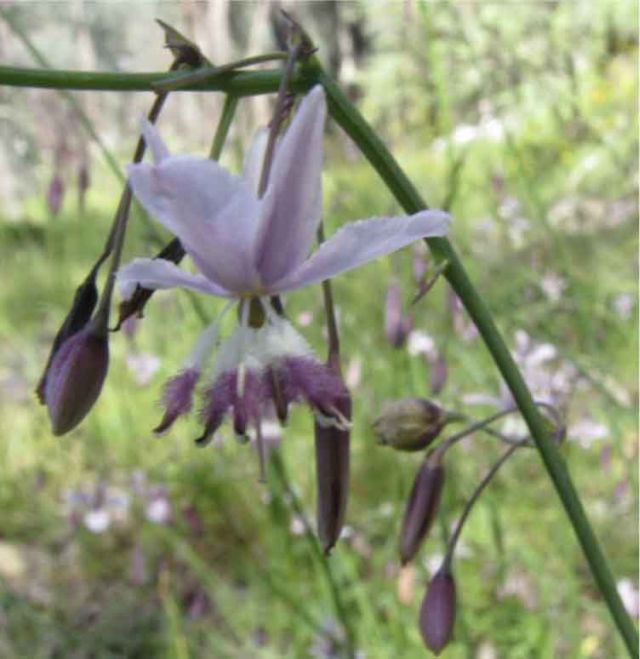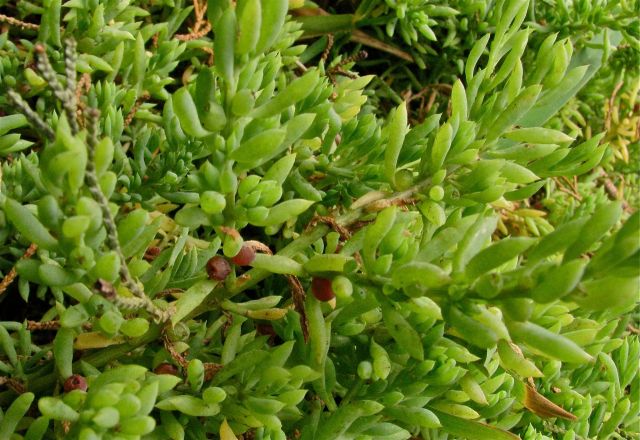Summer, after the carpets of flowers we experience in the springtime, is often thought of as a quieter time for flowering plants.
However, you will be rewarded seeking out the Pale Vanilla-lily Arthropodium milleflorum a perennial found in woodland and open forest. The small whitish–pale mauve flowers of the Vanilla-lily are in clusters of 2–9, and hang downwards on slender stalks. The flowers only last a day, but have a sweet vanilla scent. Have a close look at the three petals and three sepals, which turn back, exposing the anthers and style, and of course have a smell.

Pale Vanilla-lilly
There are a number of Bluebells in flower in late spring, but one to look for, in particular, is the Sprawling Bluebell Wahlenbergia gracilis. This tufted perennial grows to about 20 cm and has many small, soft blue flowers with five petals, and does actually have a sprawling growth habit.
The Sweet Bursaria Bursaria spinosa subsp. spinosa is a handy shrub to have in the garden, as it is wonderful haven for small birds. This prickly, woody shrub has long spines among the foliage, and bears masses of fragrant creamy white flowers in summer. Larvae of the Bright Copper Butterfly feed on the leaves.

Sweet Bursaria
A quite spectacular, tall shrub, Victorian Christmas Bush Prostanthera lasianthos, can be found in woodland gullies at this time of year. It has numerous, white, two-lipped flowers, and fragrant, mint-scented leaves that have finely toothed margins and are pale green on the lower surface. Tree Everlasting Ozothamnus ferrugineus, an erect bushy shrub growing to about 3.5 m high, has clusters of tiny, scented, white flowers which form large flower heads that open in summer. As well as bird attracting, it is also a good choice to hide a fence line.

Tree Everlasting
A very pretty, small daisy worth looking out for is Blue Bottle-daisy Lagenophera stipitata, which grows in wooded areas, often in large patches. It has small, pale-blue to mauve flowers on a slender, hairy stalk and grows to 25 cm. The sticky seeds are bottle-shaped. A low spreading shrub, the Silky Daisy-bush Olearia myrsinoides, is found in a range of habitats, and is a good choice for the garden. The white flowers have an uneven appearance, as there are 2–4 white, ray-florets on each head. The dark green leaves have fine, evenly toothed margins, and the under surface is covered by silky, whitish hairs.
One to look out for on the coastal dunes is the Coast Bonefruit Threlkeldia diffusa. This perennial herb often scrambles over taller vegetation. It has inconspicuous, small, green flowers followed by purplish fruits. The seeds are very hard and bone like, hence the name.

Coast Bonefruit
Lastly, a plant that is much maligned as a parasite, is the Mistletoe. The fruit attracts a range of birds, possums and insects. Drooping Mistletoe Amyema pendula subsp. pendula hangs in dense clumps from eucalypts; the narrow, lance-shaped leaves mimic the host tree, but tend to be browner. The attractive, long red or yellow flowers hang in clusters.

Mistletoe
On your summer strolls, remember to have your copy of Flowers of Anglesea and Aireys Inlet handy.
Yvonne Coventry